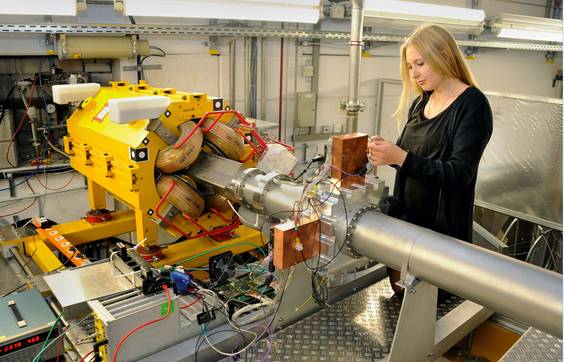29.07.2014
First use of CERBEROS detector at GSI Darmstadt
In May, the measuring system CERBEROS was put into operation at the GSI Helmholtzzentrum für Schwerionenforschung GmbH. Presently, during the July and August beam time, the detector for the first time analyzes the pions produced in the GSI accelerator facility. The research group of Prof. Dr. Laura Fabbietti from the Technische Universität München, who is also a member of the Excellence Cluster Universe, was significantly involved in the development and construction of CERBEROS.
In order to study the properties of the components of atomic nuclei - protons and neutrons - , ions are accelerated to nearly the speed of light and subsequently collide with each other at the GSI in Darmstadt. If the nuclei collide head-on, a new system with increased density emerges, and quark and anti-quark particles are combined to new particles, pions. These particles can only be produced in laboratories and do not exist on earth naturally. Prof. Dr. Laura Fabbietti and her research group aim at better understanding the pion’s properties.
Thus, the pions are sorted out by means of magnets, bundled and made to collide with other particles, thereby creating new, even more seldom particles. "To investigate these new particles, it is crucial to know the pion’s momentum with highest accuracy", says Laura Fabbietti. This is the purpose of CERBEROS. The special feature of CERBEROS is a novel microchip, that decides whether a collision event is interesting and is recorded or not. Additionally, the detector is endowed with a particularly fast and precise readout component. The new system was developed and commissioned by researchers at the GSI in collaboration with various universities. From Laura Fabbietti’s research group at the Technische Universität München, the Postdoc Dr. Ludwig Maier, the PhD student Rafal Lalik and the master student Joana Wirth were essentially involved.
After successful first measurements in May, Cerberos is currently in use in ongoing experiments. Since the concept of self-triggering readout electronics is not limited to the study of pions, parts of the system can also be used in the future international accelerator facility FAIR (Facility for Antiproton and Ion Research), which is currently being built in Darmstadt, for example, in the experiments PANDA and CBM. Also research facilities in Russia and Japan have already shown interest in CERBEROS.
Contact:
Prof. Dr. Laura Fabbietti
Excellence Cluster Universe
Technische Universität München
Boltzmannstr. 2, 85748 Garching, Germany
Tel. +49 89 35831 7118
E-Mail: laura.fabbietti@ph.tum.de






